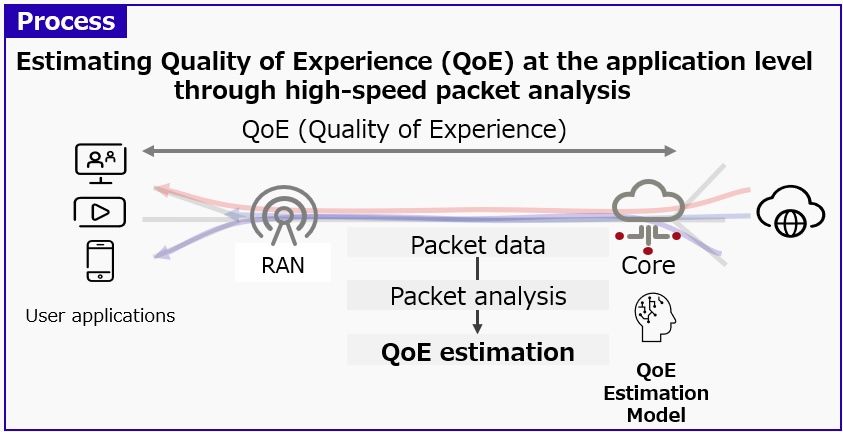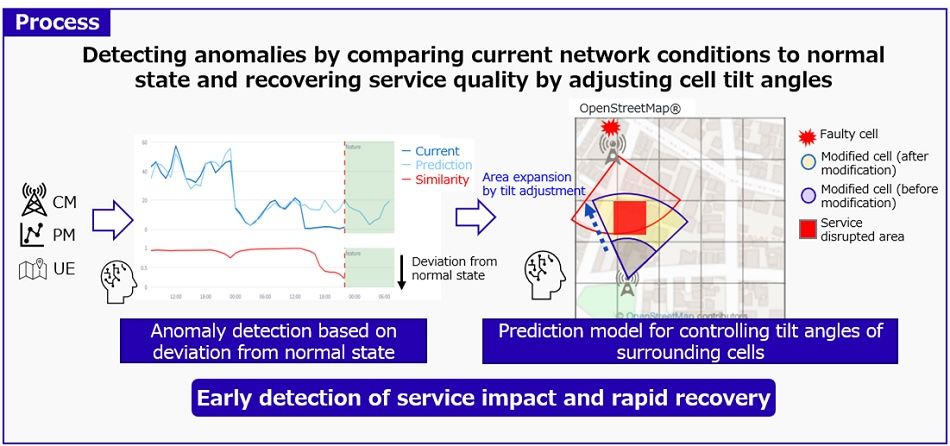KAWASAKI, Japan, Oct 15, 2024 - (JCN Newswire) - Fujitsu today announced the development of an application that leverages AI technology to enhance mobile network communication quality, while achieving energy savings and optimizing network operations.
15.10.2024 - 11:35:46Fujitsu implements global launch of world's first AI application to prevent quality degradation in 5G wireless networks. This development is part of the Research and Development Project of the Enhanced Infrastructures for Post-5G Information and Communication Systems (hereafter NEDO-led project) (1) conducted by the New Energy and Industrial Technology Development Organization (NEDO). Fujitsu, which has a successful track record of introducing radio unit (RU) products to the global market, will incorporate this technology into its O-RAN (2) compliant Service Management and Orchestration (SMO) (3) system, FUJITSU Network Virtuora Service Management and Orchestration. Fujitsu will implement a gradual global rollout of the technology to mobile network operators starting in November 2024 by leveraging the footprint it has already cultivated in RU.

 |
| Figure 2: Service quality degradation detection and recovery |
This application comprises three key technologies:An AI-powered technology that can estimate smartphone users' quality of experience (QoE) on their networks in real time.A technology that detects early signs of increased communication traffic and proactively prevents network quality degradation.A technology that detects network quality degradation and redefines the area covered by peripheral base stations to maintain optimal quality.
Fujitsu verified the effectiveness of these technologies in August 2024 using real commercial data from mobile network operators (4) under conditions closely resembling actual operating environments.
This application will ensure a seamless and reliable connection for mobile network users, not only during normal operations but also during emergencies and periods of increased network traffic, ultimately enhancing user convenience, satisfaction, and safety in critical situations. For mobile network operators, the application will reduce operational costs and save power through optimized operations.
Background
As digital transformation (DX) accelerates globally, the adoption of 5G mobile networks is rapidly expanding as a key infrastructure component. Mobile network operators are expected to further enhance their capabilities, including ultra-low latency and simultaneous connectivity, while ensuring network quality at user and application levels. Furthermore, the RAN (Radio Access Network) domain is undergoing open and virtualized transformation based on the O-RAN concept, leading to anticipated reductions in total cost of ownership (TCO).
The three technologies in this application operate on the RIC (5) deployed within the O-RAN compliant SMO, contributing to the intelligent automation and self-sufficiency of RAN.
Development achievements1. Real-time QoE estimation and quality assurance using AI
This technology estimates QoE in real-time and automatically switches users to other base station network areas when QoE degradation is detected. It is a world-first, enabling the creation of AI models that can easily estimate QoE for individual applications by selecting feature values from statistical data (KPIs) calculated from high-speed packet analysis for 100 Gbps RAN traffic. This approach allows for flexible adaptation to various applications.
By accurately understanding the QoE of each user and assigning the necessary resources, this technology ensures user convenience and satisfaction while simultaneously suppressing excessive resource allocation. This results in a 19% increase in the number of users that can be accommodated per base station (6).
Fujitsu has developed a technology that utilizes AI to anticipate increased communication traffic and proactively activate previously dormant base stations to prevent degradation in user communication quality.
Previously, energy savings were achieved by monitoring traffic in each area in real-time and putting unnecessary base stations into sleep mode. This world first technology goes a step further by detecting unusual increases in pedestrian traffic, such as those associated with local events, and predicting subsequent traffic increases at the grid level (7). This predictive technology has been proven to successfully activate base stations in advance without impacting user quality 99.8% of the time during the verification period.
This enables pinpoint activation and deactivation of base stations based on traffic conditions, achieving a balance between maintaining QoE and saving energy when combined with the energy-saving application announced by Fujitsu in December 2023 (8).
3. Detection of service quality degradation and area redesign for service quality maintenance
Traditional anomaly detection technologies for single cells (9) struggled to differentiate between simple load reductions and actual anomalies. Fujitsu's new technology addresses this by comparing traffic trends across surrounding cells using AI, achieving a fault detection accuracy rate of over 92%. This technology supports both supervised learning with limited fault data as well as unsupervised learning. By understanding the service impact including cell overlap, it is possible to make a judgement on which areas should be recovered first.
When this anomaly detection technology identifies areas undergoing significant service impact, it utilizes a radio propagation prediction model that considers path loss (10) in the real field, in addition to the direction and load conditions of surrounding cells, to calculate the optimal tilt angle for surrounding cells. This minimizes the impact on service quality caused by faulty cells. As a result, recovery time from anomalies such as equipment failure, which previously took 24 hours, has been reduced to less than one hour, minimizing the impact on users.
Future Plans
Fujitsu will continue to contribute to the realization of a safer, more secure, and sustainable society by providing O-RAN products using AI-centric technologies for networks that support applications and services across industries.
[1] NEDO-led project :Project name: Research and Development Project of the Enhanced Infrastructures for Post-5G Information and Communication Systems (JPNP20017) (Commissioned)Period: FY2021 - 2024Overview: Research and Development Project of the Enhanced Infrastructures for Post-5G Information and Communication Systems
[2] O-RAN :O-RAN refers to a Radio Access Network (RAN) built based on open interface specifications developed by the O-RAN ALLIANCE.
[3] Service Management and Orchestration (SMO) :In the O-RAN architecture, Service Management and Orchestration (SMO) defines a system that manages the operation, maintenance, and optimization of RAN, as well as its lifecycle.
[4] Commercial data from mobile network operators :This refers to data collected by mobile network operators during their actual operations. This data is used in AI development for this research and development project.
[5] RIC :Abbreviation for RAN Intelligent Controller, a controller that autonomously executes and controls RAN parameter settings and operational optimization.
[6] A 19% increase in the number of users that can be accommodated per base station :This figure was calculated based on a comparison of cell-based performance measurements and QoE-based performance measurements in Fujitsu's lab environment.
[7] Grid :A grid refers to a section on a map based on latitude and longitude.
[8] The energy-saving application announced by Fujitsu in December 2023 :This refers to an energy-saving application that applies Fujitsu's AI technology to estimate communication traffic based on the distribution of user location information in the mobile network. Press Release: "Fujitsu leverages AI technology to realize energy saving in network operations"
[9] Cell :A cell is the smallest unit of a communication area formed by the radio waves of a base station.
[10] Path loss :Path loss refers to the attenuation of radio waves as they pass through the air or are blocked by obstacles.
About Fujitsu
Fujitsu's purpose is to make the world more sustainable by building trust in society through innovation. As the digital transformation partner of choice for customers in over 100 countries, our 124,000 employees work to resolve some of the greatest challenges facing humanity. Our range of services and solutions draw on five key technologies: Computing, Networks, AI, Data & Security, and Converging Technologies, which we bring together to deliver sustainability transformation. Fujitsu Limited (TSE:6702) reported consolidated revenues of 3.7 trillion yen (US$26 billion) for the fiscal year ended March 31, 2024 and remains the top digital services company in Japan by market share. Find out more: www.fujitsu.com.
Press Contacts
Fujitsu Limited
Public and Investor Relations Division
Inquiries (https://bit.ly/3rrQ4mB)
Source: Fujitsu Ltd
Copyright 2024 JCN Newswire . All rights reserved.

